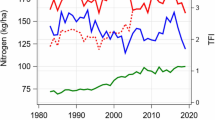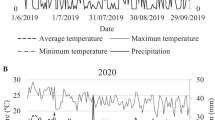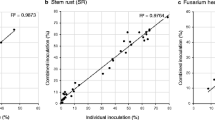Summary
The relationships between percent pycnidia coverage on the four uppermost leaves (PCD), plant height (PHT) and days to heading (HED) were evaluated for 21,000 wheat and triticale accessions tested in artificially inoculated (with fixed combination of S. tritici isolates) field nurseries over 8 trial years. A general Linear Model procedure (GLM) estimated Septoria severity using two correlative models: model 133-1 Year and model II−PCD=b1PHT+b2HED+C. The regression coefficients for PHT and HED in the two models were −0.54 and −0.40, respectively, with a R2=0.80** and R2=0.29** for model I and model II, respectively. The predicted cultivar best fitted to the model would be characterized as a semidwarf (PHT=115 cm) with an early-moderate maturity (HED=95 days to heading). The estimated mean percent pycnidial coverage for the two models over the 8 trial years was 40.8%. The performance of a group of 38 cultivars replicated yearly during the 8 trial years was assessed relative to model I. The deviation of each cultivar from the model was calculated using two functions: a) Sum Relative Serial Deviation (SRSD) and b) Total Relative deviation (TRD), in addition to Standard errors (SE). The proposed analytical protocol enabled identification of cultivars which expressed consistent yearly deviation (from the model) in host response combined with low-moderate mean pycnidial coverage (±30%). Such cultivars may possess a more stable type of genetic protection against the adverse effects of septoria tritici blotch.
Similar content being viewed by others
References
Brokenshire T., 1976. The reaction of wheat genotypes to Septoria tritici. Ann. Appl. Biol. 82: 415–423.
Danon T., J.M. Sacks & Z. Eyal, 1982. The relationships among plant stature, maturity class and susceptibility to Septoria leaf blotch of wheat. Phytopathology 72: 1037–1042.
Eyal Z., 1981. Integrated control of Septoria diseases of wheat. Plant Disease 65: 763–768.
Eyal Z. & M.B. Brown, 1976. A quantitative method for estimating density of Septoria tritici pycnidia on wheat leaves. Phytopathology 66: 11–14.
Eyal Z. & E. Levy, 1987. Variation in pathogenicity patterns of Mycosphaerella graminicola within Triticum spp. in Israel. Eyphytica 35: 237–250.
Eyal Z., I. Wahl & J.M. Prescott, 1983. Evaluation of germplasm response to Septoria leaf blotch of wheat. Euphytica 32: 439–446.
Eyal Z, A.L. Scharen, M.D. Huffmann & J.M. Prescott, 1985. Global insights into virulence frequencies of Mycosphaerella graminicola. Phytopathology 75: 1456–1462.
Eyal Z., A.L. Scharen, J.M. Prescott & M.van Ginkel, 1987. The Septoria diseases of wheat: Concepts and methods of disease management. CIMMYT Publication, Mexico, 52 pp.
Nelson L.R., M.R. Holmes & B.M. Cunfer, 1976. Multiple regression accounting for wheat yield reduction by Septoria nodorum and other pathogens. Phytopathology 66: 1375–1379.
Parlevliet J.E., 1988. Strategies for the utilization of partial resistance for the control of cereal rusts. p. 48–62. In: N.E. Nelson & S. Rajaram (Eds). Breeding strategies for resistance to the rusts of wheat. CIMMYT, Mexico, 151 pp.
Rosielle A.A., 1972. Sources of resistance in wheat to speckled leaf blotch caused by Septoria tritici. Euphytica 21: 152–161.
Scott P.R., P.W. Benedikz & C.J. Cox, 1982. A genetic study of the relationship between height, time of ear emergence and resistance to Septoria nodorum in wheat. Plant Pathology 31: 45–60.
Shaner G. & R.E. Finney, 1982. Resistance in soft red winter wheat to Mycosphaerella graminicola. Phytopathology 72: 154–158.
Shaner G., R.E. Finney & F.L. Patterson, 1975. Expression of effectiveness of resistance to septoria leaf blotch. Phytopathology 65: 761–766.
Tavella C.M., 1978. Date of heading and plant height of wheat varieties as related to Septoria leaf blotch damage. Euphytica 27: 577–580.
Tottman D.R. & R.J. Makepeace, 1979. An explanation of the decimal code for the growth stages of cereals, with illustrations. Ann. Appl. Biol. 93: 221–234.
Yechilevich-Auster M., E. Levi & Z. Eyal, 1983. Assessment of interactions between cultivated and wild wheats and Septoria tritici. Phytopathology 73: 221–234.
Author information
Authors and Affiliations
Rights and permissions
About this article
Cite this article
Eyal, Z., Talpaz, H. The combined effect of plant stature and maturity on the response of wheat and triticale accessions to Septoria tritici . Euphytica 46, 133–141 (1990). https://doi.org/10.1007/BF00022306
Received:
Accepted:
Issue Date:
DOI: https://doi.org/10.1007/BF00022306




